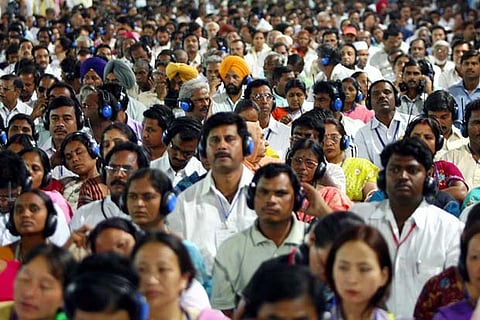

Chennai
The UP Population (Control, Stabilisation and Welfare) Bill 2021 was unveiled in the backdrop of World Population Day, observed on July 11. The state’s Population Policy 2021-2030 aims to lower the fertility rate from the current rate of 2.7 to 2.1 by 2026 and 1.9 by 2030. The Assam government had also mulled the enforcement of a two-child policy through legislation that could be introduced during this month’s budget session. As per the law, it could provide those with up to two children, eligibility for government jobs and welfare schemes, like subsidised ration.
As per UP’s bill, public servants following the two-child norm will be eligible for additional increments during their service. Other states have taken a cue as the Gujarat government has also begun weighing the implications of introducing such legislation. BJP’s national general secretary CT Ravi, an MLA from Karnataka who is also in charge of Tamil Nadu, Maharashtra, and Goa, demanded this week that Karnataka should also bring in a new population policy similar to that of UP.
Citizens in UP are turning out to be unwilling pawns in this ‘voluntary’ initiative, which had a covert soft launch. Last week, an unmarried, differently-abled man from Agra was taken to the district hospital by an Asha worker under the pretext of vaccinating him for COVID. Instead, he ended up getting sterilised. The Asha worker was keen on completing the target set by the district health department ahead of World Population Day, which would have earned her an incentive of Rs 400, and the operated individual, a sum of Rs 3,000.
The incident brought back memories from the Emergency era India when Congress leader Sanjay Gandhi spearheaded a compulsory sterilisation programme. Between 1976 and 1977, 8.3 mn sterilisations were carried out by the government (a majority of them being coerced), a jump from the 2.7 mn procedures held the previous year. Following widespread condemnation, family planning was deemed a voluntary affair since then. India happens to be one of the first countries to adopt family planning, and a programme for the same was unveiled in 1952 . India’s population at 135 cr could surpass that of China’s (142 cr) by 2024-25. Experts have questioned the logic of strong-arm tactics, especially when statistics point the other way. In UP, with a population of 240 mn, the birth rate has dropped 50 per cent between 1993 and 2016. And it is estimated that the number of children per mother could drop to 2.1. As per the Fifth National Family Health Survey, the nation’s Total Fertility Rate (TFR) in 2020 was 2.2 births per woman. South Indian states have a TFR that is lower than both the national average and the desired TFR of 2.1.
So, what is prompting states to embark on such measures? Both UP and Gujarat are set to face the assembly elections next year. And opposition parties allege the BJP is attempting to stoke a communal nerve by introducing such laws, which UP’s CM has categorically refuted. Nobel laureate Amartya Sen has outlined in his 1994 essay Population: Delusion and Reality, that coercive attempts at birth control are not the endgame for our population crisis. Sen compares the fertility rates prevalent in 1979, in Tamil Nadu at 3.5, Kerala at 3.0 and China at 2.8. In 1991, the fertility rates had dropped to 2.2, 1.8, and 2.0, respectively. He cited the attempts of the two south Indian states which encouraged a voluntary and collaborative reduction in birth rates, as compared to China’s strict one-child policy.
The drafting of laws that could be seen as an example of pitting one community against the other is certainly not the approach to be adopted by the states. Instead, the focus should be on improving primary and reproductive healthcare infrastructure, as well as undertaking grassroots level programmes to educate economically constrained communities in making the right choices
Visit news.dtnext.in to explore our interactive epaper!
Download the DT Next app for more exciting features!
Click here for iOS
Click here for Android